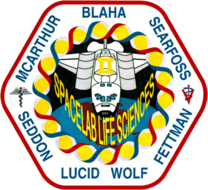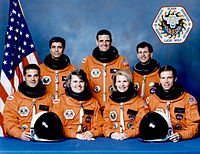STS-58
| Missionsemblem | |||||
|---|---|---|---|---|---|
 | |||||
| Missionsstatistik | |||||
| Missionsnavn: | STS-58 | ||||
| Rumagentur: | NASA | ||||
| Rumfartøjets navn: | Columbia (15) | ||||
| Antal besætningsmedlemmer: | 7 | ||||
| Affyringsrampe: | 39A KSC | ||||
| Opsendelse: | 18. oktober 1993 | ||||
| Landing: | 1. november 1993 | ||||
| Landet på: | Edwards Air Force Base | ||||
| Varighed: | 14 dage og 0 timer | ||||
| Foto af besætningen | |||||
 | |||||
| Navigation | |||||
| |||||
STS-58 var Columbias 14. rumfærge-mission. Opsendt 18. oktober 1993 og vendte tilbage den 1. november 1993.
Besætning

 John Blaha (kaptajn)
John Blaha (kaptajn)
 Richard Searfoss (pilot)
Richard Searfoss (pilot)
 Margaret Seddon (1. nyttelastspecialist)
Margaret Seddon (1. nyttelastspecialist)
 William McArthur (1. missionsspecialist)
William McArthur (1. missionsspecialist)
 David Wolf (2. missionsspecialist)
David Wolf (2. missionsspecialist)
 Shannon Lucid (3. missionsspecialist)
Shannon Lucid (3. missionsspecialist)
 Martin Fettman (2. nyttelastspecialist)
Martin Fettman (2. nyttelastspecialist)
Missionen
Hovedartikler:
Eksterne henvisninger
- STS-58 NASA (engelsk)
| ||||||||
Medier brugt på denne side
Forfatter/Opretter: By Rei-artur (diskussion · bidrag)., Licens: CC-BY-SA-3.0
Venus/female symbol.
STS058-76-041 (18 Oct-1 Nov 1993) --- Backdropped against the Peru-Bolivia border and part of the Amazon basin, the Spacelab Life Sciences (SLS-2) laboratory module was captured with a 70mm camera, by one of the seven crew members inside the Space Shuttle Columbia's cabin. Part of the tunnel-like passageway is visible in the foreground. Six NASA astronauts and a veterinarian from the private sector spent two weeks devoted to medical research in Earth-orbit. Lake Titicaca, the largest high-altitude lake in the world lies in the Altiplano of Bolivia and Peru. Space Shuttle photography has been used to document fluctuations of several meters of the level of Lake Titicaca during the past decade, as well as to document the eutrophication of the north end of the lake, which is primarily due to increased population in the Peruvian shoreline areas. This view shows the effect of abnormally heavy precipitation of the region for the third successive year. Meteorologists feel this precipitation increase, which may portend another increase of the lake level, is due to the third successive El Nino - Southern Oscillation phenomenon in the 1993 - 94 southern hemisphere summertime.
The STS-58 crew portrait includes astronauts (seated left to right) David A. Wolf, Shannon W. Lucid, and Rhea Seddon, all mission specialists; and Richard A. Searfoss, pilot. Standing in the rear, left to right, are John E. Blaha, commander; William S. McArthur, Jr., mission specialist; and Martin J. Fettmen, payload specialist. Launched aboard the Space Shuttle Columbia on October 18, 1993 at 10:53:10 a.m. (EDT), STS-58 served as the second dedicated Spacelab Life Sciences (SLS-2) mission.
Space Shuttle Columbia is about to touch down on the runway at Edwards Air Force Base in California. The main landing gear of Columbia stirs up dust on the runway as it begins to touchdown
This scene represents the end of NASA's STS-1 mission and the beginning of STS-2 in that the orbiter Columbia is arriving at Kennedy Space Center in Florida to begin the lengthy process of preparing it for STS-2. The vehicle landed at Dryden Flight Research Center on April 14 after an historic 2 1/3 day flight in Earth orbit. It was mated to this 747 aircraft, titled NASA 905, and flown over the USA to its Florida destination. It was later removed from atop NASA 905 and moved to the orbiter processing facility for the beginning of refurbishment.
STS-58 Crew Insignia
Forfatter/Opretter: Rei-artur (diskussion · bidrag), reshaped by F l a n k e r (talk), Licens: CC-BY-SA-3.0
symbol of Mars. 400 × 400 pixels nominal dimensions, line 45 pixel tick, circle 295 × 295 pixel, not joined with arrow. Colour: red=0 green=0 blue=140.
![]() Vektorgrafikken blev lavet med Inkscape.
Vektorgrafikken blev lavet med Inkscape.










